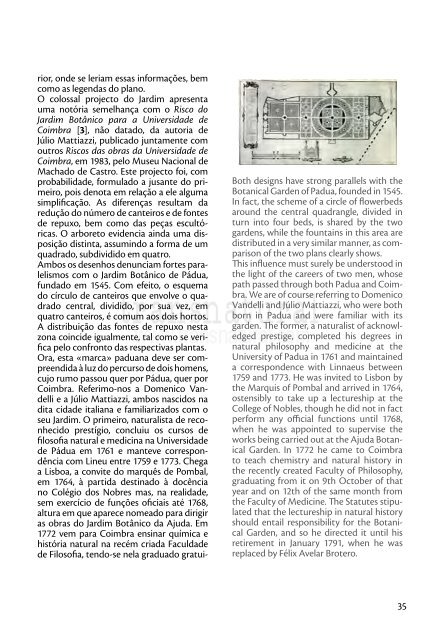Jardim Botânico de Coimbra: contraponto entre a Arte e a ... - artez
Jardim Botânico de Coimbra: contraponto entre a Arte e a ... - artez
Jardim Botânico de Coimbra: contraponto entre a Arte e a ... - artez
You also want an ePaper? Increase the reach of your titles
YUMPU automatically turns print PDFs into web optimized ePapers that Google loves.
ior, on<strong>de</strong> se leriam essas informações, bem<br />
como as legendas do plano.<br />
O colossal projecto do <strong>Jardim</strong> apresenta<br />
uma notória semelhança com o Risco do<br />
<strong>Jardim</strong> <strong>Botânico</strong> para a Universida<strong>de</strong> <strong>de</strong><br />
<strong>Coimbra</strong> [3], não datado, da autoria <strong>de</strong><br />
Júlio Mattiazzi, publicado juntamente com<br />
outros Riscos das obras da Universida<strong>de</strong> <strong>de</strong><br />
<strong>Coimbra</strong>, em 1983, pelo Museu Nacional <strong>de</strong><br />
Machado <strong>de</strong> Castro. Este projecto foi, com<br />
probabilida<strong>de</strong>, formulado a jusante do primeiro,<br />
pois <strong>de</strong>nota em relação a ele alguma<br />
simplificação. As diferenças resultam da<br />
redução do número <strong>de</strong> canteiros e <strong>de</strong> fontes<br />
<strong>de</strong> repuxo, bem como das peças escultóricas.<br />
O arboreto evi<strong>de</strong>ncia ainda uma disposição<br />
distinta, assumindo a forma <strong>de</strong> um<br />
quadrado, subdividido em quatro.<br />
Ambos os <strong>de</strong>senhos <strong>de</strong>nunciam fortes paralelismos<br />
com o <strong>Jardim</strong> <strong>Botânico</strong> <strong>de</strong> Pádua,<br />
fundado em 1545. Com efeito, o esquema<br />
do círculo <strong>de</strong> canteiros que envolve o quadrado<br />
central, dividido, por sua vez, em<br />
quatro canteiros, é comum aos dois hortos.<br />
A distribuição das fontes <strong>de</strong> repuxo nesta<br />
zona coinci<strong>de</strong> igualmente, tal como se verifica<br />
pelo confronto das respectivas plantas.<br />
Ora, esta «marca» paduana <strong>de</strong>ve ser compreendida<br />
à luz do percurso <strong>de</strong> dois homens,<br />
cujo rumo passou quer por Pádua, quer por<br />
<strong>Coimbra</strong>. Referimo-nos a Domenico Van<strong>de</strong>lli<br />
e a Júlio Mattiazzi, ambos nascidos na<br />
dita cida<strong>de</strong> italiana e familiarizados com o<br />
seu <strong>Jardim</strong>. O primeiro, naturalista <strong>de</strong> reconhecido<br />
prestígio, concluiu os cursos <strong>de</strong><br />
filosofia natural e medicina na Universida<strong>de</strong><br />
<strong>de</strong> Pádua em 1761 e manteve correspondência<br />
com Lineu <strong>entre</strong> 1759 e 1773. Chega<br />
a Lisboa, a convite do marquês <strong>de</strong> Pombal,<br />
em 1764, à partida <strong>de</strong>stinado à docência<br />
no Colégio dos Nobres mas, na realida<strong>de</strong>,<br />
sem exercício <strong>de</strong> funções oficiais até 1768,<br />
altura em que aparece nomeado para dirigir<br />
as obras do <strong>Jardim</strong> <strong>Botânico</strong> da Ajuda. Em<br />
1772 vem para <strong>Coimbra</strong> ensinar química e<br />
história natural na recém criada Faculda<strong>de</strong><br />
<strong>de</strong> Filosofia, tendo-se nela graduado gratui-<br />
Both <strong>de</strong>signs have strong parallels with the<br />
Botanical Gar<strong>de</strong>n of Padua, foun<strong>de</strong>d in 1545.<br />
In fact, the scheme of a circle of flowerbeds<br />
around the central quadrangle, divi<strong>de</strong>d in<br />
turn into four beds, is shared by the two<br />
gar<strong>de</strong>ns, while the fountains in this area are<br />
distributed in a very similar manner, as comparison<br />
of the two plans clearly shows.<br />
This influence must surely be un<strong>de</strong>rstood in<br />
the light of the careers of two men, whose<br />
path passed through both Padua and <strong>Coimbra</strong>.<br />
We are of course referring to Domenico<br />
Van<strong>de</strong>lli and Júlio Mattiazzi, who were both<br />
born in Padua and were familiar with its<br />
gar<strong>de</strong>n. The former, a naturalist of acknowledged<br />
prestige, completed his <strong>de</strong>grees in<br />
natural philosophy and medicine at the<br />
University of Padua in 1761 and maintained<br />
a correspon<strong>de</strong>nce with Linnaeus between<br />
1759 and 1773. He was invited to Lisbon by<br />
the Marquis of Pombal and arrived in 1764,<br />
ostensibly to take up a lectureship at the<br />
College of Nobles, though he did not in fact<br />
perform any official functions until 1768,<br />
when he was appointed to supervise the<br />
works being carried out at the Ajuda Botanical<br />
Gar<strong>de</strong>n. In 1772 he came to <strong>Coimbra</strong><br />
to teach chemistry and natural history in<br />
the recently created Faculty of Philosophy,<br />
graduating from it on 9th October of that<br />
year and on 12th of the same month from<br />
the Faculty of Medicine. The Statutes stipulated<br />
that the lectureship in natural history<br />
should entail responsibility for the Botanical<br />
Gar<strong>de</strong>n, and so he directed it until his<br />
retirement in January 1791, when he was<br />
replaced by Félix Avelar Brotero.<br />
35


